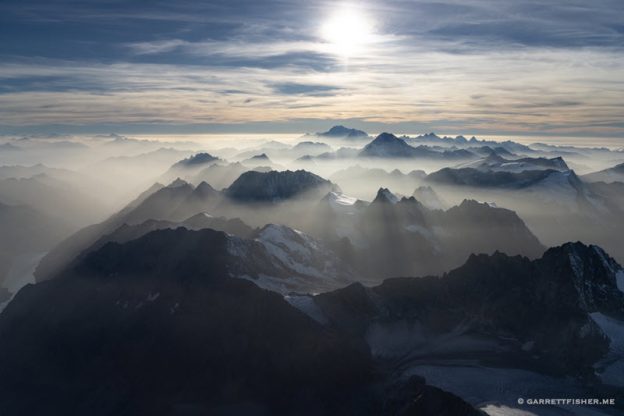The mystery began on what should have been an illustrious autumn morning in the Alps. Peering out my window, I was greeted with sun and a magnificent scene as expected; however, the air was defiled with haze. While that can be typical in the Flachland between Geneva and Zürich, and particularly dense with northeast winds in early spring, there was no reason for its presence after a front had blown through.
Come to think of it, the mystery extended about four to five days prior to when I took a flight to the Pyrenees. I ran into a smoke layer obfuscating part of Mont Blanc, so I flew under it, noting that it dissipated between Grenoble and Valence, France. Looking at the satellite map, I assumed that it was dust from the Sahara, getting wrapped around a strong low that was tracking east from Trieste, Italy, with winds potentially wrapping from the east around the front of the Alps. “It should blow out in a day or so,” I said to myself, hoping my trip to the Pyrenees wouldn’t be ruined.
It didn’t blow out. It was still there when I flew back, though it was not in the Pyrenees at all. Again, I was sure with the passage of a front and some precipitation that some classic autumn weather was due and yet, here I was, looking at a treasure of a view with thick haze obfuscating it. My wife strolled to the window and said, “What a beautiful day!” “It is disgusting! Look at that haze!” I replied. “There is a bit of haze but look how nice it is outside.”
The nice thing about airplanes is that one can fly above such defiled air masses, which I attempted to do that afternoon. For some reason, the layer was much deeper than expected and deeper than it should be with high pressure moving in. I surfaced the haze at 11,000 feet, which would be something more endemic to a high-pressure zone in midsummer, not in autumn.
As I frolicked around the Matterhorn, it was clear to me that the layer was inconsistently placed. Usually, high pressure creates a firm inversion layer that is relatively consistent in altitude on the Italian and Swiss sides of the Alps. It showed variation, and I couldn’t dispel the nagging sense something was amiss. I snapped an iPhone shot into the sun to demonstrate the depth of haze, texted it to a pilot friend, and he replied how pretty the photo was. “It is filth,” I replied.
As sunset approached, I descended into said filth, now at about 10,500 feet near Martigny, and it smelled of smoke. “How could this be?” I thought to myself, “The only way it could be this thick is if the Vosges is on fire, but I doubt it.” Cruising into the circuit confirmed I was in some curious soup.
The next day, I had some business to attend to, using the Super Cub. It was sunny that morning as well, still defiled out the window, so by this point, I was wondering why an explanation wasn’t on the news. I had a diversion to the Jungfrau before heading to the Jura. I could see the haze layer was incredibly thick over the lowlands, with a more compressed layer than before, and thicker than I had ever seen it below. There was also a secondary higher layer over Italy. I was concerned the descent to land in the Jura would place me in IFR, though it was MVFR, and smelled again of smoke.
Returning from the Jura, Chasseral was sticking out above the smoke, so it meant the layer was shallow. As I approached the Bernese Oberland, it thickened, however, and showed two layers.
After landing, I couldn’t take it. Where on earth was this haze coming from? Meteo Swiss was to the rescue the next day, in German, with a long explanation showing upstream airflow analysis. Where was the smoke coming from? Canada! That is the first since I have come to Europe. I have seen Martian orange sand blow into the Alps from Africa, but not to date thick smoke from Canada. Source: ‚Garrett Fisher‚.


